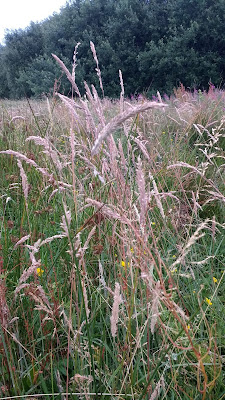Allow
some of the mixed hedging to flower for pollinators
I’ve been reading a load of interesting information about
pollinators this week. I have found the www.pollinators.ie
website very informative where it goes into detail about the the All-Ireland
Pollinator Plan. The plan addresses pollinator decline and was officially
launched in September 2015 in collaboration between The National Biodiversity
Data Centre and the Heritage Council.
All-Ireland
Pollinator Plan
One third of our bee species are threatened with extinction
from Ireland. This is because we have drastically reduced the amount of food
(flowers) and safe nesting sites in our landscapes. The All-Ireland Pollinator
Plan is about all of us, from farmers to local authorities, to schools,
gardeners and businesses, coming together to try to create an Ireland where
pollinators can survive and thrive. Buncrana has a lot of places on the
interactive map on the website and the community gardens in Carndonagh are on
there too. I’ve chosen a specific topic to highlight from their Resources pages
which is something most of us, especially farmers can contribute to, the safe
care of our hedgerows.
Hedgerows for
Pollinators
What is pollination and why is it so important?
Pollination is a vital action in nature; it is the means by
which plants fertilise each other in order to produce viable seed to keep the
species going.
In some plants pollen is spread by wind, others require the
actions of insects to transfer the pollen from the male to the female flower.
These insects (honeybees, bumblebees, solitary bees, hoverflies and others) are
known as pollinators. In general trees and
shrubs that produce blossom (whitethorn, blackthorn, cherry, crab apple, etc.)
are insect pollinated and those that produce catkins (hazel, alder, birch, oak,
poplar) are wind-pollinated. The exception is the ‘pussy’ willow which produces
an insect pollinated catkin. The blossoming species are often the woodland-edge
species and so are the ones most commonly found in hedgerows.
Healthy ecosystems (and therefore healthy pollinator
populations) are essential for sustainable agricultural production.
How do hedgerows
support pollinators?
Good quality hedgerows provide the four essential needs of
pollinators:
•Sources of pollen and nectar for food
•Places to breed
•Places to overwinter
•Corridors and pathways to travel across the landscape
Most agricultural crops that require pollinators only
provide a food source for a few weeks – diverse hedgerows and flower-rich
verges can provide food over a much longer period to fill the hungry gaps.
What makes a good
quality hedgerow for pollinators?
Food Source
Trees, shrubs and wild flowers in hedgerows provide food throughout
the season from spring to autumn. Dandelion, blackthorn and pussy willow are
very valuable in the spring when little other food is available. Mature
whitethorn provides a good source of food later in the spring, followed by
elder. Later in the season ivy provides a critical food supply.
Places to breed and
overwinter
Open fields provide few opportunities for bumblebees to nest
but hollows and holes in hedge banks along with tussocky grass in hedge margins
are ideal. The hollow stems of dead brambles provide nesting and over-wintering
sites for cavity nesting solitary bees. Hedgerows that have sandy, earth, or
earth and stone banks provide ideal nesting and over-wintering sites for mining
solitary bees, particularly if they are south facing.
Corridors
When moving between their nest and feeding sites most
pollinators like to follow linear features like hedgerows which give them some
protection from the wind and rain. Hedgerows and other linear landscape
features in agricultural landscapes can increase the connectivity between
otherwise isolated plant and pollinator populations so well-connected networks
of hedgerows are important to increase pollinator movement and pollen
transfer.
Hedgerow Management
Hedgerow management for pollinators needs to be considered
as part of the wider context of other management objectives – stock control,
shelter, screening, etc.
New hedgerows for
Pollinators
Planting a diverse range of species is key
Many common and uncommon hedgerow species will provide food
for pollinators. Some native hedgerow
species that are insect-pollinated this can be affected by a number of factors
such as local climate and altitude. Blackthorn, Wild Cherry, Crab apple, Rowan
,Whitebeam Spindle, Whitethorn/Hawthorn Guelder Rose and Elder are some of the
more well known varieties.
Shrubs like gorse and climbers like wild rose, honeysuckle
and brambles also provide food and habitat for pollinators. Hedgerow species need to be suitable for
their environment (soil and climate) and complementary to each other – in some
situations some species can become dominant and push out less vigorous species.
Try and select a suitable mix that will provide blossom throughout the
season.
Ensure good
connectivity between hedgerows and other natural and semi-natural habitats
If you can link in your new hedge with other natural and
semi-natural habitats in your area then this will make it easier for
pollinators to get to and from your new hedge safely and will complement the
general ecology of the area. Remember that areas of scrub are also important sources
of food for pollinators.
The brochure continues with advice about connecting
hedgerows and managing existing hedgerows
for pollinators stressing that over management of the hedgerows by
advising about timing and repairing hedges.
For more on the subject and other advice check out the Pollinators.ie website









